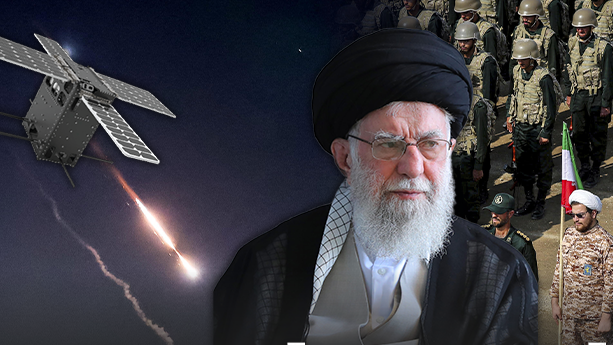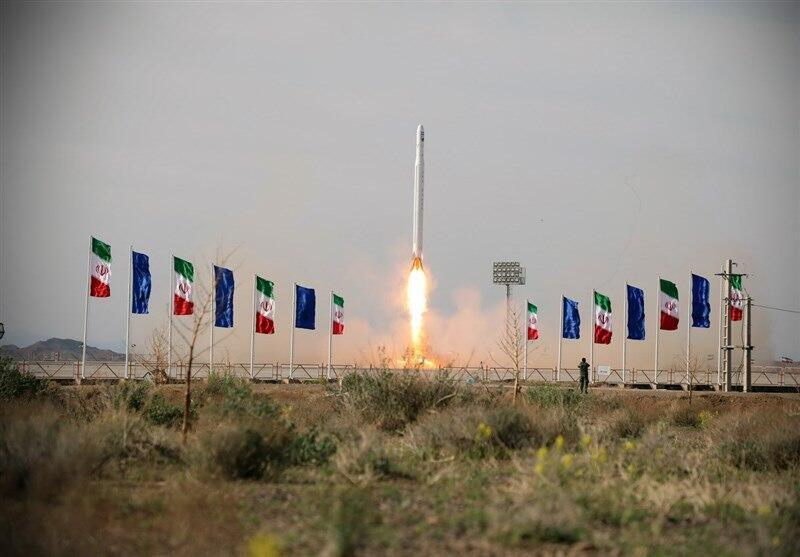Getting your Trinity Audio player ready...
Iran’s military ambitions are no secret, and its space program reflects its growing capabilities. Over the past two decades, Iran has developed and refined its space technology through two key channels: the Iranian Space Agency and the Islamic Revolutionary Guard Corps (IRGC). While the space agency focuses on civilian projects, the IRGC runs a separate, state-directed program that includes the development of advanced spy satellites and launch vehicles.
In recent years, Iran has launched more than 15 satellites, some in collaboration with Russia. Officially, the country claims these launches serve civilian purposes, such as agriculture and research. However, experts warn of a systematic military effort concealed behind this civilian front.
The West is particularly alarmed by Iran’s integration of satellite imaging capabilities, missile development and strengthened ties with Russia. These advancements not only enhance Iran’s surveillance and intelligence-gathering abilities but also support its long-range ballistic missile program, raising significant security concerns.
Tal Inbar, a missile and space expert, explains Iran’s dual-track approach: “Iran has a space agency conducting intensified civilian and scientific activities, including developing various satellite launchers and satellites. Most Iranian satellite launchers are based on ballistic missile technology. The program began in the mid-1990s, with the first successful space launch in 2009.”
The IRGC, Inbar notes, operates its own separate space initiative: “The Revolutionary Guard is responsible for designing and launching both satellites and the missiles that carry them. They have conducted several successful launches and also procure surveillance satellites from Russia, with Russian assistance in launching them. At least one is operational, and more launches are planned for the future.”
Two militaries, one goal
Iran operates two distinct military entities: the Iranian army and the IRGC, each with separate missions. The regular army focuses on defending Iran’s borders from external threats, while the IRGC is tasked with safeguarding the Islamic Revolution and spreading it beyond Iran’s borders.
Despite their differing goals, the two forces often collaborate. Over the years, the Iranian army has undergone significant changes, with its leadership aligning closely with the IRGC.
Recent Iranian attacks on Israel were carried out by the IRGC, but reports from The Wall Street Journal and Qatar’s The New Arab suggest that the upcoming operation, already dubbed “True Promise 3” in Iran, could involve the regular army as well, particularly in response to the death of four Iranian soldiers in Israel's strike last October.
Breakthrough in Iran’s private space sector
Meanwhile, Iran’s space program has seen a new milestone with the emergence of a private sector initiative. Last week at 2:48 a.m. Tehran time, the Iranian private company Space Omid successfully launched its first two satellites into orbit using a Russian-made launcher.
The satellites, named Hodhod and Kawthar, were reportedly designed by young Iranian scientists. Kawthar, an observation satellite weighing 30 kilograms, was developed in 2019 and has a lifespan of over three years. It is intended for applications such as agriculture and land surveying. Hodhod, a compact 4-kilogram communication satellite, has a four-year lifespan and supports multiple uses, including agriculture, environmental monitoring, transportation and land surveys.
The launch marks a significant step in diversifying Iran’s space program, which has traditionally been dominated by government efforts through the IRGC and other state entities.
Academia joins Iran’s space ambitions
Iran’s technological universities play a significant role in the country’s space research and development infrastructure, according to Inbar. “Many satellites have been built at these institutions, ostensibly for civilian purposes,” he said.
Experimental space launches involving short-duration flights are also conducted as part of these academic efforts, alongside the development of a suborbital manned spacecraft. Inbar explained that this type of craft reaches space without entering Earth’s orbit. “All of this is considered part of the civilian activities of the Iranian Space Agency,” he added.
Inbar emphasized that Iran’s space programs have not accelerated due to the region’s current tensions but have progressed steadily over years of planning. “Space programs are not adjusted on short timelines because of a conflict or war,” he said. “The recent launches are not tied to current tensions—they operate independently of regional circumstances.”
Iran became the 43rd country to achieve a presence in space in 2005 with the launch of its first satellite, Sina-1, from the Plesetsk Cosmodrome in northern Russia. Since then, the nation has made advancements in satellite technology, providing services such as communication, navigation, scientific research and weather forecasting.
After developing key infrastructure and satellite designs, Iran began launching satellites independently, made possible by constructing domestic launch facilities. Among the most notable are the Khomeini Space Center in Semnan, the Qom Space Station, the Alborz Space Center and a new launch site under construction in Chabahar.
Iran’s early satellite launches had mixed success. Sina-1, built in Russia at Iran’s request, was successfully launched in 2005 but later veered off course due to technical issues, losing communication with Earth.
In 2009, Iran launched Omid (“Hope” in Persian), the first satellite designed and built entirely domestically. The launch, conducted from Semnan, made Iran the ninth country in the world to send an indigenously produced satellite into orbit using a locally developed launcher. Israel was the eighth country to achieve this milestone, doing so in 1988.
3 View gallery


Footage released by Iranian media shows the launch of the Sharman-1 satellite using a space rocket developed by the Revolutionary Guard
In 2011, Iran launched the Rasad satellite, designed to provide disaster monitoring, environmental data, meteorology and temperature measurements. According to Hamid Fazeli, the former head of the Iranian Space Agency, Rasad was Iran’s first satellite capable of taking images. However, its mission ended after three weeks when it failed to deliver any photographs.
In February 2012, Iran launched the Navid satellite, reportedly tasked with capturing images from 1,000 kilometers (620 miles) above Earth. A second version, the Tadbir satellite, was planned but never succeeded. Navid itself burned up in the atmosphere, and the launch was deemed a failure.
Another Iranian satellite, Fajr, was launched in 2015 from the Semnan Space Center using the Safir launcher, capable of carrying small satellites weighing up to 50 kilograms. However, Fajr’s operational life was short-lived.
Several other satellites have also faced failed launches, including Tolou 1 from the Imam Khomeini Base in 2017, Payam in 2019, Dousti in 2019 and Zafar 1 in 2020. These setbacks highlight the challenges Iran continues to face in developing a robust space program.
Despite these failures, Iran achieved a significant breakthrough in 2020 with the launch of Noor 1, the first satellite developed by the IRGC. Noor 1 orbits Earth every 90 minutes and is capable of surveillance missions. It was launched using the Qased satellite launcher, a new system developed by the IRGC. The program has since expanded with subsequent launches of Noor 2 and Noor 3.
Iran-Russia space cooperation
The Khayyam satellite, an Iranian satellite built by a Russian company at the request of the Iranian Space Agency, underscores the deepening ties between Tehran and Moscow. Launched into orbit in 2022, Iranian officials claimed the satellite would be used solely for civilian purposes.
However, Western officials warned at the time that it could enable Iran to spy on targets in Israel and across the Middle East. Equipped with high-resolution imaging capabilities, Khayyam can capture photos with a resolution of approximately 70 centimeters per pixel.
The technology used for satellite launchers could accelerate the timeline for developing intercontinental ballistic missiles (ICBMs), as both rely on similar technology. Such long-range missiles could eventually carry nuclear warheads.
“The fact that Iran has access to observation satellites with decent resolution and the ability to share this data with its allies in the region is not ideal,” said Inbar. “There are two aspects to consider: one is infrastructure intelligence, such as monitoring the construction of facilities and bases in Israel, which is valuable for Iran. The second is the potential to deliver near-real-time intelligence under certain conditions.”
Another issue lies in the development of satellite launchers. The U.S. has accused Iran of violating United Nations Security Council resolutions with its space launches, asserting that the technology used for satellite launchers could accelerate the timeline for developing intercontinental ballistic missiles (ICBMs), as both rely on similar technology. Such long-range missiles could eventually carry nuclear warheads.
One of the most significant developments in recent years has been the creation of a new satellite launcher by the IRGC, according to Inbar. “It’s called Qaem 100, with an upgraded version, Qaem 105, in the works,” he explained. “This satellite launcher uses solid fuel for all its stages—technology that is also used in long-range ballistic missiles capable of reaching distances of 5,000 kilometers or more.”
Inbar noted that there is no pressing technological need for a satellite launcher of this kind. “The fact that it was developed, especially by the IRGC, suggests that it is a way to advance long-range missile technologies under the guise of civilian purposes,” he said.
In May, Ali Jafar Abadi, head of the IRGC’s aerospace division, announced that the Qaem 105 would be operational by next spring, calling it “one of Iran’s most important projects.” He added that the Qaem 105 would be capable of carrying twice the payload of its predecessor, the Qaem 100.
According to Inbar, Iran’s financial investment in these areas is driving its progress. “Iran is allocating significant funds and making advancements,” he said. “In ballistic missiles, satellite launchers and ground infrastructure, as well as advanced drones, Iran is achieving tangible results.”
Get the Ynetnews app on your smartphone:




